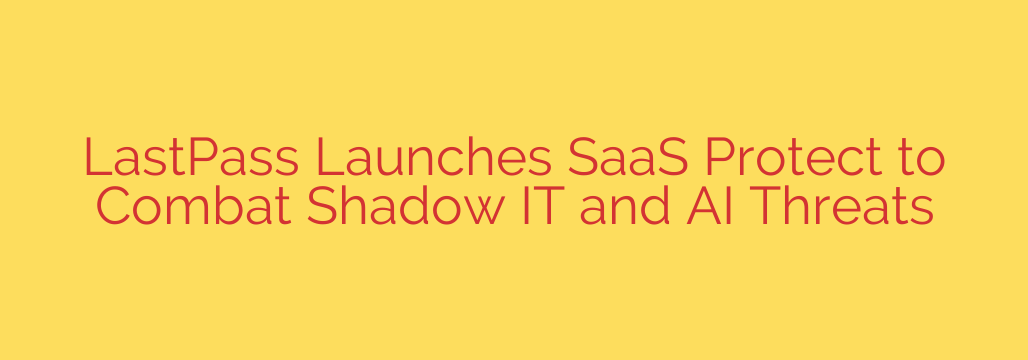
Are Unapproved Apps and AI Putting Your Business at Risk? How to Regain Control
In today’s fast-paced digital workplace, employees are constantly adopting new tools to boost productivity. From collaborative platforms and project management software to the latest generative AI assistants, the number of applications used daily has exploded. While this drive for efficiency is commendable, it has also given rise to a significant and often invisible security threat: Shadow IT.
When employees use software and services without the knowledge or approval of the IT department, they create dangerous blind spots in your company’s security posture. This problem is now being amplified by the rapid adoption of AI tools, introducing new avenues for sensitive data leakage. Understanding these risks is the first step toward building a more secure and resilient organization.
The Persistent Danger of Shadow IT
Shadow IT isn’t a new concept, but its scale is larger than ever. It happens when an employee, often with good intentions, signs up for a new cloud-based service (SaaS) because it’s quick, easy, and helps them do their job better. The problem is that the IT department has no visibility into this application.
This creates several critical risks:
- Lack of Security Oversight: Unvetted applications may not meet your company’s security standards. They could have weak password policies, lack multi-factor authentication (MFA), or have known vulnerabilities.
- Data Silos and Leakage: Company data stored in unapproved apps is outside of corporate control. If an employee leaves, that data could be lost or, worse, remain accessible to them.
- Compliance and Regulatory Issues: Industries with strict data handling regulations (like healthcare or finance) can face severe penalties if sensitive data is found on non-compliant, unapproved platforms.
- Wasted Resources: Businesses may be unknowingly paying for multiple redundant services when a single, approved solution already exists.
The core issue with Shadow IT is the loss of visibility and control. You cannot protect what you cannot see.
Generative AI: The New Frontier of Risk
The rise of powerful generative AI tools like ChatGPT has added a new and alarming dimension to Shadow IT. Employees are using these platforms to draft emails, write code, summarize documents, and analyze data. While incredibly useful, these actions pose a direct threat of data exfiltration.
Consider an employee who pastes a segment of proprietary source code into an AI chatbot to ask for debugging help. Or a marketing manager who uploads a list of customer contacts to an AI tool to generate personalized email campaigns.
In these moments, sensitive intellectual property and confidential customer data are fed directly into a third-party model. This data could potentially be used to train the AI, stored indefinitely on its servers, or even surface in response to another user’s query. This creates an irreversible data leak that is nearly impossible to trace or remediate.
A Modern Solution: Unifying Discovery, Management, and Security
Fighting a modern, decentralized problem requires a modern, centralized solution. Simply banning all unapproved apps is often impractical and can stifle innovation. Instead, businesses need a strategy that embraces productivity while eliminating security blind spots.
The most effective approach is to implement a system that provides a single, comprehensive view of every SaaS application being used across the organization. This includes both company-sanctioned apps and those operating in the shadows.
An effective SaaS management platform should deliver on three key principles:
- Automated Discovery: The system must be able to automatically detect and identify every application an employee accesses, regardless of whether it was approved by IT. This eliminates blind spots and provides a complete inventory of your SaaS ecosystem.
- Centralized Management: Once an application is discovered, IT administrators need a central dashboard to manage it. From this dashboard, they should be able to approve, restrict, or monitor access to specific applications and apply consistent security policies across the board.
- Enforced Security: Visibility is not enough. The platform must enable IT to enforce critical security controls on all applications, including those that are part of Shadow IT. This means mandating strong passwords and, most importantly, requiring multi-factor authentication (MFA) to secure access.
Actionable Steps to Secure Your SaaS Environment
Regaining control over your application ecosystem is crucial for protecting your business. Here are actionable steps every organization should take:
- Gain Full Visibility: Deploy a tool that can discover all SaaS and AI applications in use. Start by understanding the full scope of the problem to make informed decisions.
- Establish Clear Policies: Create and communicate a clear Acceptable Use Policy for software and AI tools. Educate employees on the risks of using unapproved services and provide a formal process for requesting and vetting new applications.
- Centralize and Secure Access: Implement a solution that unifies access management. By managing all application credentials and access rights from one place, you can ensure that security policies are applied universally.
- Make MFA Non-Negotiable: Enforce multi-factor authentication wherever possible. MFA is one of the single most effective controls for preventing unauthorized access, even if login credentials are stolen.
The digital workplace will only continue to evolve. Proactively managing your SaaS and AI footprint is no longer just an IT task—it’s a fundamental business imperative for safeguarding your data, reputation, and competitive edge.
Source: https://www.helpnetsecurity.com/2025/08/04/lastpass-saas-protect-released/








